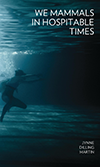And nature looks back
Galway Kinnell’s poem “On the Oregon Coast” centers around a dinner conversation with the poet Richard Hugo on the topic of personification. “We agreed,” Kinnell writes, “that eighteenth- and nineteenth-century poets almost had to personify, it was like mouth-to-mouth resuscitation, the only way they could imagine to keep the world from turning into dead matter.” But in the wake of Darwin’s revelations that man evolved from and with his fellow beasts, Kinnell concludes, poets should “anthropomorphize the world less and animalize, vegetabilize, and mineralize ourselves more.” A noble stance, if a slippery one: ecological thinking still gets shot through with human longing, and can still sink into the murky waters of what Kinnell calls “pre-Darwinian language.” After telling us that Hugo has died, Kinnell concludes his poem with an image of a log “bouncing down the beach” before it “plunges as though for good into the water.” The log stands for Hugo, mineralized—but that means the log is personified, too. Stricken by grief, Kinnell imbues dead matter with extra life, using nature for his own literary purposes.
Reading Jynne Dilling Martin’s We Mammals in Hospitable Times, it is easy to imagine her—given a time machine—zooming back to Kinnell and Hugo’s dinner table. In Martin’s poems, animals, vegetables, and minerals collide and blur and throw one another into relief. She’s interested less in the overwhelming force of Darwin than in the crackling of particulars: polar bears at the zoo wake up in a snowstorm; a biologist drills into a sea snail to hear its heartbeat; a woman marries a worm. As the collection’s title makes clear, Martin animalizes humans—“I dream / of our youthful fucking, our softness, how in ancient times we had tails”—but she also personifies animals and, by their sheer proximity, makes humans and animals resemble one another. “The snake crawling out of her skin pulls it inside out / like a nylon stocking: I wonder who would recognize me now,” she writes. If the “I” is the poet, she’s got some snake in her, too.
To Martin, man is part of nature but also sees it at a distance: in picture books where a “whale battles a horned sea monster,” at a circus where a donkey can “stomp out answers to questions.” Yet humans aren’t the only spectators: “The microscope zooms in on a freshly formed eyeball // gazing expectantly back.” Elsewhere, as the planet warms, “the noise made...
You have reached your article limit
Sign up for a digital subscription and continue reading all new issues, plus our entire archives, for just $1.50/month.
Already a subscriber? Sign in





